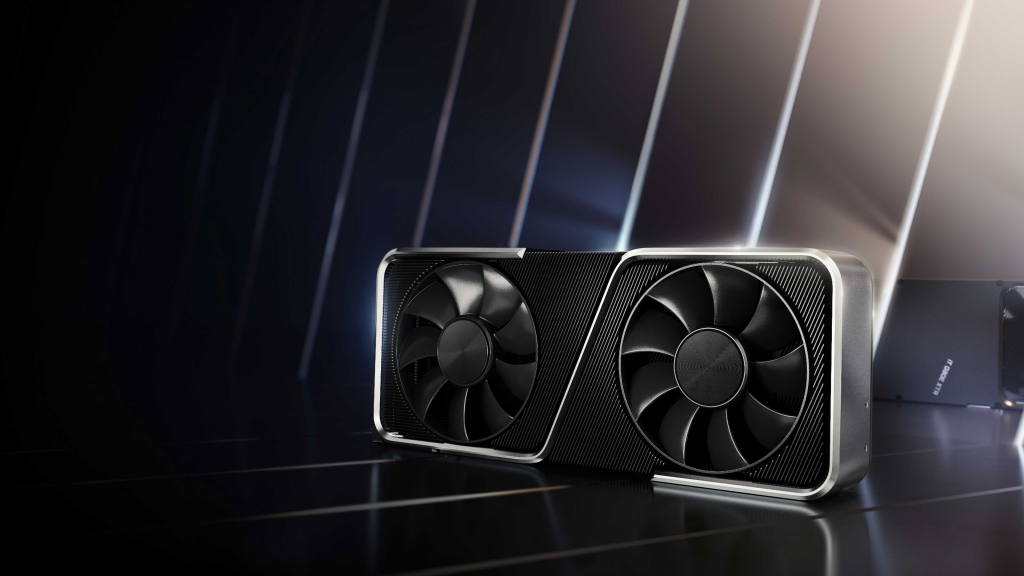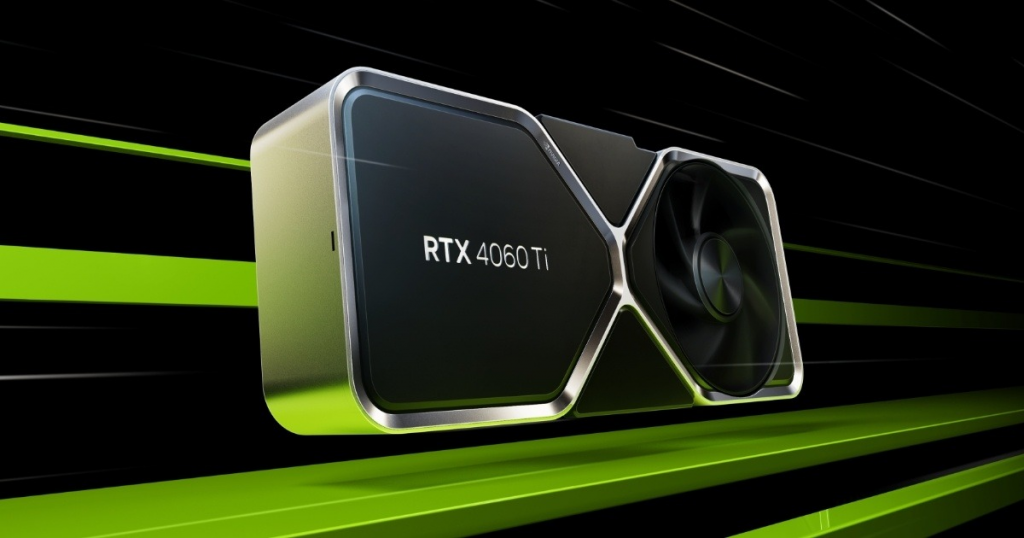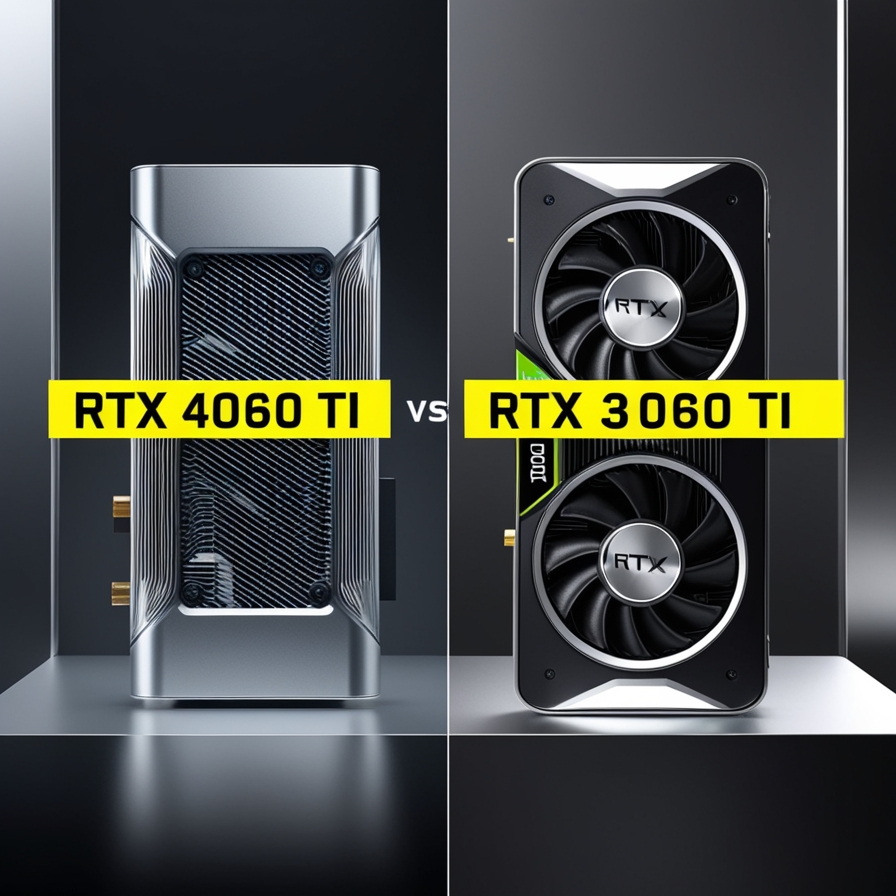Choosing the right graphics card is crucial for gamers and creators. NVIDIA’s GeForce RTX 3060 Ti and RTX 4060 Ti are popular mid-range options that offer impressive performance for a variety of tasks. In this guide, we’ll compare these two GPUs to help you determine which one is the best fit for your needs.
Understanding the GeForce RTX 3060 Ti

The GeForce RTX 3060 Ti, part of NVIDIA’s 30-series, is based on the Ampere architecture. This GPU is known for its strong performance at 1080p and 1440p resolutions. Here are some key aspects:
- Architecture: Ampere, featuring second-generation RT cores and third-generation Tensor Cores for enhanced gaming and AI performance.
- CUDA Cores: 4,864 cores, providing robust parallel processing capabilities.
- Memory: 8 GB GDDR6 with a 256-bit interface and 448 GB/s memory bandwidth, which supports high data throughput for complex tasks.
The RTX 3060 Ti delivers smooth gameplay and handles demanding applications efficiently. It supports NVIDIA’s DLSS 2.0, which uses AI to improve performance without sacrificing visual quality.
Exploring the GeForce RTX 4060 Ti

The GeForce RTX 4060 Ti, part of NVIDIA’s newer 40-series, is built on the Ada Lovelace architecture. This GPU brings advancements in performance and efficiency. Here’s a closer look:
- Architecture: Ada Lovelace, offering improved efficiency and higher performance.
- CUDA Cores: 4,352 cores, with higher clock speeds compared to the 3060 Ti.
- Memory: 8 GB GDDR6 with a 128-bit interface and 288 GB/s bandwidth, optimized for modern applications despite having a narrower interface.
The RTX 4060 Ti benefits from its higher clock speeds and newer architecture, providing enhanced performance in ray tracing and DLSS 3.0, making it a strong competitor in the mid-range GPU market.
Side-by-Side Comparison
Here’s a comparative chart of the RTX 3060 Ti and RTX 4060 Ti:
| Specification | GeForce RTX 3060 Ti | GeForce RTX 4060 Ti |
|---|---|---|
| Architecture | Ampere | Ada Lovelace |
| CUDA Cores | 4,864 | 4,352 |
| Memory | 8 GB GDDR6 | 8 GB GDDR6 |
| Memory Interface Width | 256-bit | 128-bit |
| Memory Bandwidth | 448 GB/s | 288 GB/s |
| Base Clock | 1.41 GHz | 2.31 GHz |
| Boost Clock | 1.67 GHz | 2.54 GHz |
| Ray Tracing Performance | 34 RT TFLOPs | 51 RT TFLOPs |
| DLSS Support | DLSS 2.0 | DLSS 3.0 |
| Release Date | December 2020 | May 2023 |
| Price Range (at launch) | $399 USD | $399 USD |
Architectural Differences
The architectural differences between the RTX 3060 Ti and RTX 4060 Ti are notable. The 3060 Ti, built on the Ampere architecture, includes second-generation ray tracing cores and third-generation Tensor Cores, which significantly enhance gaming performance and AI-driven features like DLSS.
In contrast, the RTX 4060 Ti benefits from the Ada Lovelace architecture. This newer architecture provides improved clock speeds and efficiency, with enhanced ray tracing cores and fourth-generation Tensor Cores, offering superior performance in many scenarios.
Performance Breakdown: RTX 3060 Ti vs. RTX 4060 Ti
When comparing the RTX 3060 Ti and RTX 4060 Ti, it’s essential to consider their performance across different tasks—gaming, productivity, and power efficiency.
Gaming Performance
For gamers, both GPUs offer excellent performance, but the RTX 4060 Ti edges out slightly thanks to its newer architecture and higher clock speeds. At 1080p and 1440p, the 4060 Ti typically delivers 10-15% better performance, especially in ray tracing and DLSS-enabled titles. However, the 3060 Ti remains a strong contender, providing consistent frame rates and smooth gameplay in most modern games.
| Feature | GeForce RTX 3060 Ti | GeForce RTX 4060 Ti |
|---|---|---|
| 1080p Gaming | Smooth gameplay with high settings | Enhanced performance, especially in ray tracing and DLSS |
| 1440p Gaming | Consistently high frame rates | Higher frame rates, particularly in demanding titles |
| 4K Gaming | Struggles with demanding games at max settings | Slightly better, but still limited for high-end 4K gaming |
Productivity and Content Creation
Beyond gaming, the RTX 4060 Ti’s improvements shine in productivity tasks. While the RTX 3060 Ti handles video editing, 3D rendering, and other creative tasks with ease, the RTX 4060 Ti offers slightly faster rendering times and better efficiency, making it a better choice for professionals who frequently engage in content creation or AI-driven tasks.
| Task | GeForce RTX 3060 Ti | GeForce RTX 4060 Ti |
|---|---|---|
| Video Editing | Strong performance in most editing software | Slightly faster exports and rendering |
| 3D Rendering | Excellent with CUDA, slower on OptiX | Faster rendering with improved OptiX support |
| AI and Machine Learning | Capable but limited by older Tensor Cores | Enhanced performance with 4th-gen Tensor Cores |
Power Efficiency and Cooling: A Key Consideration
One of the most significant differences between these GPUs is power efficiency. The RTX 3060 Ti requires a 600W power supply and has a TDP of 200W. It’s generally efficient but requires a good cooling solution to maintain optimal performance.
On the other hand, the RTX 4060 Ti is more power-efficient, with a TDP of 160W, making it easier to cool and better suited for smaller builds or systems with limited power supplies. This lower power draw, combined with improved cooling technologies, makes the 4060 Ti a quieter and more efficient option, especially for those with constrained setups.
Memory and Bandwidth: What You Need to Know
The memory interface and bandwidth are crucial factors in determining GPU performance, particularly in memory-intensive tasks like rendering large datasets or gaming with high-resolution textures. The RTX 3060 Ti’s 256-bit memory interface with 448 GB/s bandwidth provides ample throughput for most tasks. In contrast, the RTX 4060 Ti, with its 128-bit interface and 288 GB/s bandwidth, might seem like a downgrade at first glance. However, thanks to advanced memory compression and caching techniques, the 4060 Ti performs on par with or better than the 3060 Ti in real-world scenarios.
| Feature | GeForce RTX 3060 Ti | GeForce RTX 4060 Ti |
|---|---|---|
| Memory Interface Width | 256-bit | 128-bit |
| Memory Bandwidth | 448 GB/s | 288 GB/s |
| Impact on Gaming | Handles complex scenes with ease | Slightly lower bandwidth, mitigated by compression |
| Impact on Productivity | Excellent for large textures | Competitive, with potential limits in extreme cases |
Price-to-Performance: Where Does Your Money Go?
When it comes to bang for your buck, the RTX 3060 Ti remains a top choice, offering high-end performance at a mid-range price. The 4060 Ti, while slightly more expensive, offers better future-proofing, particularly if you’re planning on playing the latest games or engaging in content creation.
Which GPU is Right for You?
Ultimately, the decision between the RTX 3060 Ti and RTX 4060 Ti depends on your specific needs and budget. If you’re a casual gamer looking for great value, the RTX 3060 Ti is an excellent choice, providing solid performance without overspending. However, if you’re a competitive gamer, content creator, or someone looking to future-proof their system, the RTX 4060 Ti is worth the investment for its improved efficiency, better ray tracing performance, and advanced AI capabilities.
Final Thoughts: Future-Proofing Your Choice
The GeForce RTX 3060 Ti and RTX 4060 Ti are both exceptional GPUs, but they cater to slightly different audiences. The RTX 3060 Ti continues to be a strong contender for gamers and creators who want excellent performance at a reasonable price. Meanwhile, the RTX 4060 Ti offers superior efficiency, future-proofing, and performance, making it the better choice for those looking to invest in the latest technology.
Whichever GPU you choose, both the RTX 3060 Ti and RTX 4060 Ti will provide you with a fantastic gaming experience and robust performance in productivity tasks. The key is to align your choice with your specific needs, ensuring that your investment will serve you well in the years to come.

Leave a Reply
You must be logged in to post a comment.